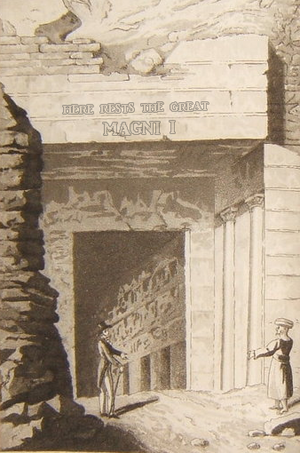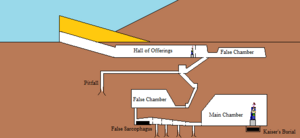Valley of Mors (burial site)

The Valley of Mors is a valley to the Northwest of Shirekeep and located in the Imperial County bailiwick of the same name that not entirely infrequently finds itself a part of Alalehzamin under Elwynnese occupation depending on which way the political wind is blowing. The valley was named after the Cedrist God of Death, Mors, and is used to bury Kaisers and very important and influential nobles.
Description
The Kaisers are buried in tombs which are constructed during the life of the Shirerithian Head of State. Once dead, the Kaiser is buried in a decorated tomb with important and precious artefacts. The valley itself is easily to protect as there is just one entrance, which is blocked by the temple and walls of Sakatopolis.
Guard towers are located upon the hills to avoid that, most likely Babkhan, thugs can steal the precious goods and sell it for cheap vodka. During when the guards were now employees of the Arandur of the Babkhi dominated Emirate of Alalehzamin and Utasia, the long term success of this arrangement was now open to investigation. With the arrival of the Scholae Sathrati in Sakatopolis in 1658 AN, the former guards were crucified and more satisfactory security arrangements put in place by the Imperial Government. A number of artefacts were returned by the former custodians in return for an amnesty - after a suitable interlude during which the terms were honoured the families of the thieves were subsequently collected by agents of the Crypteia, arraigned before a sympathetic magistrate and dispatched to forestry camps in Oleslaad.
The Valley was opened by Kaiser Gaelen IV. However, the first Kaiser to be buried within it has been Magni, who abdicated in favour of Gaelen IV.
List of buried people
- Kaiser Magni (1575)
- Kaiser Gaelen IV (1578)
- Kaiser Reynardine II (1584)
- Kaiseress Isa IV Cassandrae (1620)
- Kaiser Fish XII (1620)
- Kaiser Dominus (1645)
- Kaiseress Noor (1650)
- Kaiser Hjalmar Redquill (1651)
- Kaiser Ayreon IV (1685)
- Prince Kir, eldest son of Kaiser Ayreon IV (1703)
- Emperor Nathan II, husband of Kaiser Ayreon IV (1717)
- Jaap van Pijpervale, catamite of Kaiser Ayreon IV (1741)
- Chrysostom Wythe, Steward (1722)
- Kaiseress Salome (1748)
Tombs

Tomb of Kaiser Magni I
The Tomb of Magni I was constructed during the reign of his successor in 1575 AN. It became a simple tomb without too much expensive artwork. The architects, however, made it so that each afternoon when the sun is on it highest point, it lights up the room within the tomb where the Kaiser is buried.
Magni was buried in it two years after his abdication: 1576 AN.
Tomb of Kaiser Gaelen IV
- A film fragment from the Tomb at the outside has been made by Fides and is viewable here.
Construction works were started for the tomb after his ascension of the Throne and coronation. The Kaiser appointed the Gralan Fides as his chief architect, who constructed a marvellous temple for the Kaiser for just 300 Erb.

Construction
Construction works were started at the tomb after his ascension of the Throne and coronation. The Kaiser appointed the Gralan Fides as his chief architect, who constructed a marvellous temple for the Kaiser for just 300 Erb.
Later, Dingo Enterprises (ran by Nathan of Natopia) took over and started designing the plans for the interior design of the complex. This stayed hidden for public as long as the Kaiser was alive and even a long time after the death of the Kaiser, in 1578 AN. The plans were made public in 1603 AN to some important bureaucrats to inspire future designs for other Kaisers.
The Tomb
The Entrance
It is entered via an impressive sculpture door in an architectural design (made by Fides), which is represented schematically as the yellow wedge. After descending a shallow ramp, it opens up to the colonnaded Hall of Offerings.
Hall of Offerings

This long narrow room is fed light by the outside which, when the sun is right, illuminates the former Kaiser's statue at the end. Each wall is supported by columns and mirrors.
The Hall of Offerings may be accessed regularly by priests and mourners to deposit goods and pay respects. It's the only public room which is accessible for the living. Behind the statue however, is a false wall that, if somehow breached opens to the burial complex below.
False chambers
The safety of the Kaiser's most precious belongings and His own remains is maintained by the series of false chambers and dead ends, pitfalls, and a false sarcophagus holding the body of a servant to dissuade robbers or later archaeologists from continuing to the main chamber.
Burial chamber


Finally, the end of the complex is the burial chamber which holds a heroic sized painted marble statue of you as well as your sword and hourglass.
Tomb of Kaiseress Isa IV Cassandrae
The eternal resting place of Kaiseress Isa IV Cassandrae can be found in the northern end of the Valley of Mors.
As instructed in her last will and testament (though it was written before her ascension to the throne, it was rigorously followed), the Kaiseress had wished for a simple funeral with only her closest friends and neighbours attending, and a simple headstone without ornaments and decorations (only text).
Accordingly, the Kaiser's Court, after heavy negotiations with the Court of the Prince, arranged for the funeral and burial of the late Kaiseress, as well as funding all graves' upkeep in the Valley of Mors.
The headstone is inscribed with her Elw, Farewellish and regal names, and the dates of her birth and death in Farewellish:
- ELSA KASSANDREDOTTAR
- ELSA KASANRAJON
- KEISARYNJA ISA 4 CASSANDRAE
- ELSA KASSANDREDOTTAR
- FYDD 16 OSKALTEK 1479
- DOYD 23 RYGAL 1620
- FYDD 16 OSKALTEK 1479
Tomb of Kaiser Dominus Tarjeisson

Construction of Kaiser Dominus Tarjeisson's tomb commenced in the year 1645 during the reign of his successor Kaiseress Noor, after regurgitated remains of His late Imperial Magnificence had been discovered. His remains were put in bio-degradable jar and subsequently placed inside a flawless, full-sized wax work figurine of the former Kaiser. The aforesaid Kaiseral effigy was in turn placed inside a jade funeral suit.
Kaiser Dominus's tomb will be hewed into the valley's limestone cliffs and will be adorned with frescos depicting edifying scenes from the Kaiser's life and reign. The Kaiser will be laid to rest in a granite sarcophagus studded with onyx and lapis lazuli.
Tomb of Noor

Construction of Kaiseress Noor's tomb was initiated in mid-1645 AN. It is believed that the birth of her grandchild precipitated the decision to begin its design.
After passing through the entryway and down an unadorned corridor, one encounters a highly-decorated corridor, with side chambers that document the different phases of Noor's life and reign in painted relief. Following this, the craftsmen encountered a fault that required a redesign, realigning the rest of the tomb sideways.
The main offertory chamber, supported by four stout columns, is the furthest down portion of the tomb that remains accessible; it is decorated by images of Noor performing her sacred duties as Kaiser and high priestess. Following Noor's burial, the descending gateway was sealed and capped with an altar. Down a series of less-heavily-adorned descending corridors, the Main Burial Chamber is extensive, supported by eight stout columns and a vaulted ceiling; it is decorated with depictions of the ascended plane and prayers for the dead.
Beyond the burial chamber is a prayer hall, implicitly for the deceased Kaiseress to perform her own rituals to the gods as an intercessor to those who perform pilgrimages to her tomb.
Tomb of Ayreon IV

Planning for Kaiser Ayreon IV's tomb began shortly after he reach majority. Construction began slowly in 1663 AN and was put on hiatus in 1671 AN, due to the tumult of the Kalirion Fracture.
Construction only resumed in 1680 AN, after his successor, Kaiseress Salome, reached majority. In the interim, his body remained in cold storage in the depths of Raynor's Keep, under the watchful eye of his faithful concubine, Isidora IV of Octavius-Teleni. The decision had been made at this point to revise the design so as to include only as many rooms as necessary to satisfy Imperial protocol. Major excavation completed in 1682 AN, with final completion of the reliefs and frescos in early 1685 AN. This allowed for a burial to coincide with what would have been his fortieth birthday.
More modest than the one constructed for his predecessor and grandmother, its design reflected the more modest means available to the Imperial Republic during this period.
Uniquely among the tombs in the Valley of Mors, the Tomb of Ayreon IV connects to the Tomb of Noor with a false door, allowing for attendants at one tomb to pay homage to the image of the other. Ayreon IV's body was laid to rest at the end of an incomplete corridor, originally intended to continue and lead down into the burial chamber proper. Due to his death and the ensuing Kalirion Fracture, this corridor was instead enlarged and decorated with the necessary images of the ascended plane and prayers for the dead. The rushed nature of the tomb's completion also resulted in an offertory chamber with relatively light ornamentation.
Burial took place on 8.III.1685 AN, attended by the Imperial Family, courtiers, and foreign dignitaries.
Following his burial, the Imperial Mother, Isidora IV of Octavius-Teleni, commissioned the construction of a small living facility to adjoin the surface complex, so that she would be able to reside permanently on site and act as a caretaker for the location.
After the untimely death of Prince Kir of Shireroth, an annex to the Tomb of Ayreon IV was excavated for his remains to be interred.
In 1717, Ayreon's husband Emperor Nathan II of the Natopians was interred next to him. Nathan had not remarried since the death of his husband in 1671.